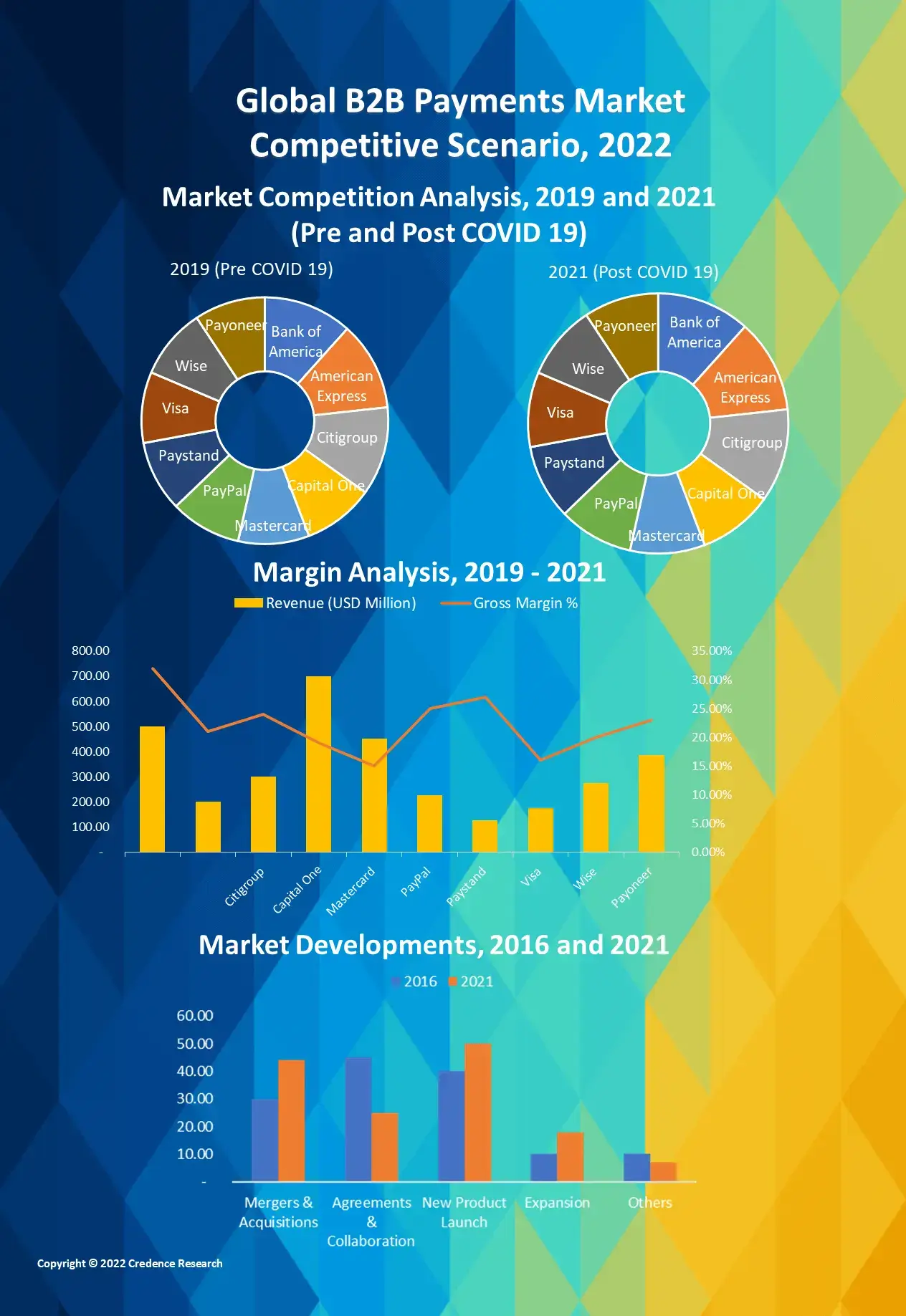1. Preface
1.1. Report Description
1.1.1. Purpose of the Report
1.1.2. Target Audience
1.1.3. USP and Key Offerings
1.2. Research Scope
1.3. Research Methodology
1.3.1. Phase I – Secondary Research
1.3.2. Phase II – Primary Research
1.3.3. Phase III – Expert Panel Review
1.3.4. Approach Adopted
1.3.4.1. Top-Down Approach
1.3.4.2. Bottom-Up Approach
1.3.5. Assumptions
1.4. Market Segmentation
2. Executive Summary
2.1. Market Snapshot: Global B2B Payments Market
3. Market Dynamics & Factors Analysis
3.1. Introduction
3.1.1. Global B2B Payments Market Value, 2016-2028, (US$ Bn)
3.2. Market Dynamics
3.2.1. Key Growth Trends
3.2.2. Major Industry Challenges
3.2.3. Key Growth Pockets
3.3. Attractive Investment Proposition,2021
3.3.1. Payment Type
3.3.2. Payment Mode
3.3.3. Enterprise Size
3.3.4. Industry Verticals
3.3.5. Geography
3.4. Porter’s Five Forces Analysis
3.4.1. Threat of New Entrants
3.4.2. Bargaining Power of Buyers/Consumers
3.4.3. Bargaining Power of Suppliers
3.4.4. Threat of Substitute Types
3.4.5. Intensity of Competitive Rivalry
3.5. Value Chain Analysis
4. Market Positioning of Key Players, 2021
4.1. Company market share of key players, 2021
4.2. Competitive Benchmarking
4.3. Geographical Presence Analysis
4.4. Major Strategies Adopted by Key Players
4.4.1. Key Strategies Analysis
4.4.2. Mergers and Acquisitions
4.4.3. Partnerships
4.4.4. Product Launch
4.4.5. Geographical Expansion
4.4.6. Others
5. COVID 19 Impact Analysis
5.1. Global B2B Payments Market Pre Vs Post COVID 19, 2019 – 2028
5.2. Impact on Import & Export
5.3. Impact on Demand & Supply
6. North America
6.1. North America B2B Payments Market, by Country, 2016-2028(US$ Bn)
6.1.1. U.S.
6.1.2. Canada
6.1.3. Mexico
6.2. North America B2B Payments Market, by Payment Type, 2016-2028(US$ Bn)
6.2.1. Overview
6.2.2. Domestic Payments
6.2.3. Cross-Border Payments
6.3. North America B2B Payments Market, by Payment Mode, 2016-2028(US$ Bn)
6.3.1. Overview
6.3.2. Traditional
6.3.3. Digital
6.4. North America B2B Payments Market, by Enterprise Size, 2016-2028(US$ Bn)
6.4.1. Overview
6.4.2. Large Enterprise
6.5. North America B2B Payments Market, by Industry Verticals, 2016-2028(US$ Bn)
6.5.1. Overview
6.5.2. BSFI
6.5.3. Manufacturing
6.5.4. IT and Telecom
6.5.5. Metals and Mining
6.5.6. Energy and Utilities
6.5.7. Others
7. Europe
7.1. Europe B2B Payments Market, by Country, 2016-2028(US$ Bn)
7.1.1. UK
7.1.2. France
7.1.3. Germany
7.1.4. Italy
7.1.5. Russia
7.1.6. Ukraine
7.1.7. Spain
7.1.8. Belgium
7.1.9. Netherland
7.1.10. Austria
7.1.11. Sweden
7.1.12. Poland
7.1.13. Denmark
7.1.14. Switzerland
7.1.15. Rest of Europe
7.2. Europe B2B Payments Market, by Payment Type, 2016-2028(US$ Bn)
7.2.1. Overview
7.2.2. Domestic Payments
7.2.3. Cross-Border Payments
7.3. Europe B2B Payments Market, by Payment Mode, 2016-2028(US$ Bn)
7.3.1. Overview
7.3.2. Traditional
7.3.3. Digital
7.4. Europe B2B Payments Market, by Enterprise Size, 2016-2028(US$ Bn)
7.4.1. Overview
7.4.2. Large Enterprise
7.4.3. Small and Medium-sized Enterprises
7.5. Europe B2B Payments Market, by Industry Verticals, 2016-2028(US$ Bn)
7.5.1. Overview
7.5.2. BSFI
7.5.3. Manufacturing
7.5.4. IT and Telecom
7.5.5. Metals and Mining
7.5.6. Energy and Utilities
7.5.7. Others
8. Asia Pacific
8.1. Asia Pacific B2B Payments Market, by Country, 2016-2028(US$ Bn)
8.1.1. China
8.1.2. Japan
8.1.3. South Korea
8.1.4. India
8.1.5. Australia
8.1.6. New Zealand
8.1.7. Taiwan
8.1.8. Indonesia
8.1.9. Malaysia
8.1.10. Philippine
8.1.11. Rest of Asia Pacific
8.2. Asia Pacific B2B Payments Market, by Payment Type, 2016-2028(US$ Bn)
8.2.1. Overview
8.2.2. Domestic Payments
8.2.3. Cross-Border Payments
8.3. Asia Pacific B2B Payments Market, by Payment Mode, 2016-2028(US$ Bn)
8.3.1. Overview
8.3.2. Traditional
8.3.3. Digital
8.4. Asia Pacific B2B Payments Market, by Enterprise Size, 2016-2028(US$ Bn)
8.4.1. Overview
8.4.2. Large Enterprise
8.4.3. Small and Medium-sized Enterprises
8.5. Asia Pacific B2B Payments Market, by Industry Verticals, 2016-2028(US$ Bn)
8.5.1. Overview
8.5.2. BSFI
8.5.3. Manufacturing
8.5.4. IT and Telecom
8.5.5. Metals and Mining
8.5.6. Energy and Utilities
8.5.7. Others
9. Latin America
9.1. Latin America B2B Payments Market, by Country, 2016-2028(US$ Bn)
9.1.1. Brazil
9.1.2. Argentina
9.1.3. Peru
9.1.4. Chile
9.1.5. Colombia
9.1.6. Rest of Latin America
9.2. Latin America B2B Payments Market, by Payment Type, 2016-2028(US$ Bn)
9.2.1. Overview
9.2.2. Domestic Payments
9.2.3. Cross-Border Payments
9.3. Latin America B2B Payments Market, by Payment Mode, 2016-2028(US$ Bn)
9.3.1. Overview
9.3.2. Traditional
9.3.3. Digital
9.4. Latin America B2B Payments Market, by Enterprise Size, 2016-2028(US$ Bn)
9.4.1. Overview
9.4.2. Large Enterprise
9.4.3. Small and Medium-sized Enterprises
9.5. Latin America B2B Payments Market, by Industry Verticals, 2016-2028(US$ Bn)
9.5.1. Overview
9.5.2. BSFI
9.5.3. Manufacturing
9.5.4. IT and Telecom
9.5.5. Metals and Mining
9.5.6. Energy and Utilities
9.5.7. Others
10. Middle East
10.1. Middle East B2B Payments Market, by Country, 2016-2028(US$ Bn)
10.1.1. UAE
10.1.2. KSA
10.1.3. Israel
10.1.4. Turkey
10.1.5. Iran
10.1.6. Rest of Middle East
10.2. Middle East B2B Payments Market, by Payment Type, 2016-2028(US$ Bn)
10.2.1. Overview
10.2.2. Domestic Payments
10.2.3. Cross-Border Payments
10.3. Middle East B2B Payments Market, by Payment Mode, 2016-2028(US$ Bn)
10.3.1. Overview
10.3.2. Traditional
10.3.3. Digital
10.4. Middle East B2B Payments Market, by Enterprise Size, 2016-2028(US$ Bn)
10.4.1. Overview
10.4.2. Large Enterprise
10.4.3. Small and Medium-sized Enterprises
10.5. Middle East B2B Payments Market, by Industry Verticals, 2016-2028(US$ Bn)
10.5.1. Overview
10.5.2. BSFI
10.5.3. Manufacturing
10.5.4. IT and Telecom
10.5.5. Metals and Mining
10.5.6. Energy and Utilities
10.5.7. Others
11. Africa
11.1. Africa B2B Payments Market, by Country, 2016-2028(US$ Bn)
11.1.1. South Africa
11.1.2. Egypt
11.1.3. Nigeria
11.1.4. Rest of Africa
11.2. Africa B2B Payments Market, by Payment Type, 2016-2028(US$ Bn)
11.2.1. Overview
11.2.2. Domestic Payments
11.2.3. Cross-Border Payments
11.3. Africa B2B Payments Market, by Payment Mode, 2016-2028(US$ Bn)
11.3.1. Overview
11.3.2. Traditional
11.3.3. Digital
11.4. Africa B2B Payments Market, by Enterprise Size, 2016-2028(US$ Bn)
11.4.1. Overview
11.4.2. Large Enterprise
11.4.3. Small and Medium-sized Enterprises
11.5. Africa B2B Payments Market, by Industry Verticals, 2016-2028(US$ Bn)
11.5.1. Overview
11.5.2. BSFI
11.5.3. Manufacturing
11.5.4. IT and Telecom
11.5.5. Metals and Mining
11.5.6. Energy and Utilities
11.5.7. Others
12. Global
12.1. Global B2B Payments Market, by Payment Type, 2016-2028(US$ Bn)
12.1.1. Overview
12.1.2. Domestic Payments
12.1.3. Cross-Border Payments
12.2. Global B2B Payments Market, by Payment Mode, 2016-2028(US$ Bn)
12.2.1. Overview
12.2.2. Traditional
12.2.3. Digital
12.3. Global B2B Payments Market, by Enterprise Size, 2016-2028(US$ Bn)
12.3.1. Overview
12.3.2. Large Enterprise
12.3.3. Small and Medium-sized Enterprises
12.4. Global B2B Payments Market, by Industry Verticals, 2016-2028(US$ Bn)
12.4.1. Overview
12.4.2. BSFI
12.4.3. Manufacturing
12.4.4. IT and Telecom
12.4.5. Metals and Mining
12.4.6. Energy and Utilities
12.4.7. Others
13. Company Profiles
13.1. Bank of America Corporation
13.2. American Express Company
13.3. Citigroup Inc.
13.4. Capital One
13.5. Mastercard Inc.
13.6. PayPal Holdings Inc.
13.7. Paystand Inc.
13.8. Visa Inc.
13.9. JPMorgan Chase & Co.
13.10. Payoneer Inc.
13.11. Stripe Inc.
13.12. Wise Payments Limited.
List of Figures
FIG. 1 Global B2B Payments Market: Research Methodology
FIG. 2 Market Size Estimation – Top Down & Bottom up Approach
FIG. 3 Global B2B Payments Market Segmentation
FIG. 4 Global B2B Payments Market, by Payment Type, 2021 (US$ Bn)
FIG. 5 Global B2B Payments Market, by Payment Mode, 2021 (US$ Bn)
FIG. 6 Global B2B Payments Market, by Enterprise Size, 2021 (US$ Bn)
FIG. 7 Global B2B Payments Market, by Industry Verticals, 2021 (US$ Bn)
FIG. 8 Global B2B Payments Market, by Geography, 2021 (US$ Bn)
FIG. 9 Attractive Investment Proposition, by Payment Type, 2021
FIG. 10 Attractive Investment Proposition, by Payment Mode, 2021
FIG. 11 Attractive Investment Proposition, by Enterprise Size, 2021
FIG. 12 Attractive Investment Proposition, by Industry Verticals, 2021
FIG. 13 Attractive Investment Proposition, by Geography, 2021
FIG. 14 Global Market Positioning of Key B2B Payments Market Manufacturers, 2019
FIG. 15 Global B2B Payments Market Value Contribution, By Payment Type, 2021 & 2028 (Value %)
FIG. 16 Global B2B Payments Market, by Domestic Payments, Value, 2016-2028 (US$ Bn)
FIG. 17 Global B2B Payments Market, by Cross-Border Payments, Value, 2016-2028 (US$ Bn)
FIG. 18 Global B2B Payments Market Value Contribution, By Payment Mode, 2021 & 2028 (Value %)
FIG. 19 Global B2B Payments Market, by Traditional, Value, 2016-2028 (US$ Bn)
FIG. 20 Global B2B Payments Market, by Digital, Value, 2016-2028 (US$ Bn)
FIG. 21 Global B2B Payments Market Value Contribution, By Enterprise Size, 2021 & 2028 (Value %)
FIG. 22 Global B2B Payments Market, by Large Enterprise, Value, 2016-2028 (US$ Bn)
FIG. 23 Global B2B Payments Market, by Small and Medium-sized Enterprises, Value, 2016-2028 (US$ Bn)
FIG. 24 Global B2B Payments Market Value Contribution, By Industry Verticals, 2021 & 2028 (Value %)
FIG. 25 Global B2B Payments Market, by BSFI, Value, 2016-2028 (US$ Bn)
FIG. 26 Global B2B Payments Market, by Manufacturing, Value, 2016-2028 (US$ Bn)
FIG. 27 Global B2B Payments Market, by IT and Telecom, Value, 2016-2028 (US$ Bn)
FIG. 28 Global B2B Payments Market, by Metals and Mining, Value, 2016-2028 (US$ Bn)
FIG. 29 Global B2B Payments Market, by Energy and Utilities, Value, 2016-2028 (US$ Bn)
FIG. 30 Global B2B Payments Market, by Others, Value, 2016-2028 (US$ Bn
FIG. 31 U.S. B2B Payments Market, 2016-2028 (US$ Bn)
FIG. 32 Rest of North America B2B Payments Market, 2016-2028 (US$ Bn)
FIG. 33 U.K. B2B Payments Market, 2016-2028 (US$ Bn)
FIG. 34 Germany B2B Payments Market, 2016-2028 (US$ Bn)
FIG. 35 France B2B Payments Market, 2016-2028 (US$ Bn)
FIG. 36 Italy B2B Payments Market, 2016-2028 (US$ Bn)
FIG. 37 Spain B2B Payments Market, 2016-2028 (US$ Bn)
FIG. 38 Russia B2B Payments Market, 2016-2028 (US$ Bn)
FIG. 39 BENELUX B2B Payments Market, 2016-2028 (US$ Bn)
FIG. 40 Poland B2B Payments Market, 2016-2028 (US$ Bn)
FIG. 41 Austria B2B Payments Market, 2016-2028 (US$ Bn)
FIG. 42 Rest of Europe B2B Payments Market, 2016-2028 (US$ Bn)
FIG. 43 Japan B2B Payments Market, 2016-2028 (US$ Bn)
FIG. 44 China B2B Payments Market, 2016-2028 (US$ Bn)
FIG. 45 India B2B Payments Market, 2016-2028 (US$ Bn)
FIG. 46 South Korea B2B Payments Market, 2016-2028 (US$ Bn)
FIG. 47 Australia B2B Payments Market, 2016-2028 (US$ Bn)
FIG. 48 Southeast Asia B2B Payments Market, 2016-2028 (US$ Bn)
FIG. 49 Rest of Asia Pacific B2B Payments Market, 2016-2028 (US$ Bn)
FIG. 50 Middle East & Africa B2B Payments Market, 2016-2028 (US$ Bn)
FIG. 51 South Africa B2B Payments Market, 2016-2028 (US$ Bn)
FIG. 52 Nigeria B2B Payments Market, 2016-2028 (US$ Bn)
FIG. 53 Egypt B2B Payments Market, 2016-2028 (US$ Bn)
FIG. 54 GCC B2B Payments Market, 2016-2028 (US$ Bn)
FIG. 55 Israel B2B Payments Market, 2016-2028 (US$ Bn)
FIG. 56 Latin America B2B Payments Market, 2016-2028 (US$ Bn)
FIG. 57 Brazil B2B Payments Market, 2016-2028 (US$ Bn)
FIG. 58 Argentina B2B Payments Market, 2016-2028 (US$ Bn)
FIG. 59 Colombia B2B Payments Market, 2016-2028 (US$ Bn)
FIG. 60 Peru B2B Payments Market, 2016-2028 (US$ Bn)
FIG. 61 Chile B2B Payments Market, 2016-2028 (US$ Bn)
List of Tables
TABLE 1 Market Snapshot: Global B2B Payments Market
TABLE 2 Global B2B Payments Market, by Payment Type, 2016-2028 (US$ Bn)
TABLE 3 Global B2B Payments Market, by Payment Mode, 2016-2028 (US$ Bn)
TABLE 4 Global B2B Payments Market, by Enterprise Size, 2016-2028 (US$ Bn)
TABLE 5 Global B2B Payments Market, by Industry Verticals, 2016-2028 (US$ Bn)
TABLE 6 Global B2B Payments Market, by Geography, 2016-2028 (US$ Bn)
TABLE 7 North America B2B Payments Market, by Payment Type, 2016-2028 (US$ Bn)
TABLE 8 North America B2B Payments Market, by Payment Mode, 2016-2028 (US$ Bn)
TABLE 9 North America B2B Payments Market, by Enterprise Size, 2016-2028 (US$ Bn)
TABLE 10 North America B2B Payments Market, by Industry Verticals, 2016-2028 (US$ Bn)
TABLE 11 North America B2B Payments Market, by Country, 2016-2028 (US$ Bn
TABLE 12 Europe B2B Payments Market, by Payment Type, 2016-2028 (US$ Bn)
TABLE 13 Europe B2B Payments Market, by Payment Mode, 2016-2028 (US$ Bn)
TABLE 14 Europe B2B Payments Market, by Enterprise Size, 2016-2028 (US$ Bn)
TABLE 15 Europe B2B Payments Market, by Industry Verticals, 2016-2028 (US$ Bn)
TABLE 16 Europe B2B Payments Market, by Country/Region, 2016-2028 (US$ Bn)
TABLE 17 Asia Pacific B2B Payments Market, by Payment Type, 2016-2028 (US$ Bn)
TABLE 18 Asia Pacific B2B Payments Market, by Payment Mode, 2016-2028 (US$ Bn)
TABLE 19 Asia Pacific B2B Payments Market, by Enterprise Size, 2016-2028 (US$ Bn)
TABLE 20 Asia Pacific B2B Payments Market, by Industry Verticals, 2016-2028 (US$ Bn)
TABLE 21 Asia Pacific B2B Payments Market, by Country/Region, 2016-2028 (US$ Bn)
TABLE 22 Latin America B2B Payments Market, by Payment Type, 2016-2028 (US$ Bn)
TABLE 23 Latin America B2B Payments Market, by Payment Mode, 2016-2028 (US$ Bn)
TABLE 24 Latin America B2B Payments Market, by Enterprise Size, 2016-2028 (US$ Bn)
TABLE 25 Latin America B2B Payments Market, by Industry Verticals, 2016-2028 (US$ Bn)
TABLE 26 Latin America B2B Payments Market, by Country/Region, 2016-2028 (US$ Bn)
TABLE 27 Middle East B2B Payments Market, by Payment Type, 2016-2028 (US$ Bn)
TABLE 28 Middle East B2B Payments Market, by Payment Mode, 2016-2028 (US$ Bn)
TABLE 29 Middle East B2B Payments Market, by Enterprise Size, 2016-2028 (US$ Bn)
TABLE 30 Middle East B2B Payments Market, by Industry Verticals, 2016-2028 (US$ Bn)
TABLE 31 Middle East B2B Payments Market, by Country/Region, 2016-2028 (US$ Bn)
TABLE 32 Africa B2B Payments Market, by Payment Type, 2016-2028 (US$ Bn)
TABLE 33 Africa B2B Payments Market, by Payment Mode, 2016-2028 (US$ Bn)
TABLE 34 Africa B2B Payments Market, by Enterprise Size, 2016-2028 (US$ Bn)
TABLE 35 Africa B2B Payments Market, by Industry Verticals, 2016-2028 (US$ Bn)
TABLE 36 Africa B2B Payments Market, by Country/Region, 2016-2028 (US$ Bn)













